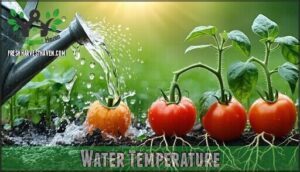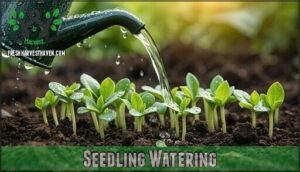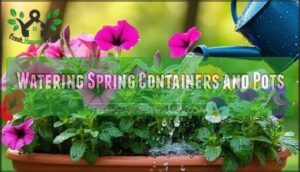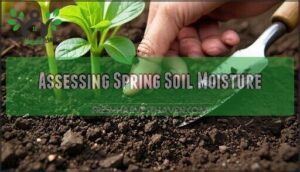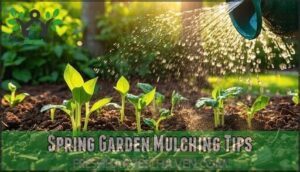This site is supported by our readers. We may earn a commission, at no cost to you, if you purchase through links.
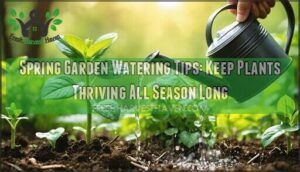
If it’s dry, water deeply until you see runoff from drainage holes. Water early morning to reduce evaporation and prevent fungal diseases.
Skip the sprinkler dance and water at soil level instead. New transplants need daily attention for their first week, while established plants prefer less frequent but thorough soaking.
Container plants dry out faster than ground plantings, so check them twice weekly. The secret lies in reading your plants’ subtle signals and timing your watering schedule perfectly, which is key to mastering your garden care.
Table Of Contents
- Key Takeaways
- Spring Garden Watering Schedule
- Watering Techniques for Spring Gardens
- Tips for Watering New Spring Plants
- Watering Spring Containers and Pots
- Assessing Spring Soil Moisture
- Recognizing Wilting and Underwatering in Spring
- Avoiding Overwatering in Spring Gardens
- Spring Garden Mulching Tips
- Spring Watering Schedules for Specific Plants
- Spring Water Conservation Strategies
- Frequently Asked Questions (FAQs)
- How do you water an early Spring Garden?
- When should you water your garden?
- How do you care for a plant in spring?
- What are the best practices for watering plants?
- How do I Keep my Garden healthy during spring?
- Should you water your garden in winter?
- How often should I water my garden in the spring?
- What is the best watering schedule for spring?
- What is the best watering schedule for a garden?
- How do you water a garden?
- Conclusion
Key Takeaways
- Test soil moisture before watering – Stick your finger 2 inches deep into the soil near plant roots; if it’s dry, water deeply until you see runoff from drainage holes
- Water early morning for best results – You’ll reduce evaporation and prevent fungal diseases while giving plants time to absorb moisture before heat stress hits
- Adjust frequency based on your soil type – Sandy soils need watering 2-3 times weekly since they drain quickly, while clay soils hold moisture longer and may only need weekly watering
- Focus on deep, thorough watering over frequent shallow sessions – You’ll encourage strong root development by watering less often but more deeply, reaching 5-6 inches down to build plant resilience
Spring Garden Watering Schedule
You’ll want to set a spring watering schedule that keeps up with changing weather, soil conditions, and your plants’ growth spurts.
By watching rainfall, feeling the soil, and adjusting as needed, you won’t have to guess whether your garden is thirsty or just being dramatic, which helps in maintaining a healthy garden with proper care.
Watering Frequency
The secret to watering frequency lies in understanding your garden’s rhythm rather than following rigid schedules.
Most spring gardens need deep watering 1-2 times weekly, but soil type dramatically affects this timing.
Sandy soils drain quickly, requiring water 2-3 times per week, while clay soils hold moisture longer and may need weekly watering.
Know your soil—sandy drinks fast, clay holds tight.
Plant stage matters too.
New transplants and seedlings need daily attention until their roots establish, then you can reduce frequency.
Established plants with deeper root systems thrive on less frequent, thorough watering.
Weather impact and seasonal changes constantly shift your watering schedule.
Check soil moisture by inserting your finger 1-2 inches deep—if it’s dry, it’s time to water.
Adjusting frequency based on rainfall, temperature, and plant growth guarantees healthier gardens.
Remember: watering deeply encourages strong root development, making your plants more resilient throughout the season.
To prevent issues such as drought and stress, supplemental watering may be necessary.
Monitoring Precipitation
Knowing exactly how much precipitation your garden receives helps you water smarter, not harder. Rainfall measurement transforms guesswork into precision, keeping your spring garden watering tips practical and effective.
- Install a rain gauge in an open area to track weekly rainfall amounts
- Use weather apps to anticipate upcoming precipitation patterns
- Monitor for soil saturation between natural watering events
- Adjust schedules based on regional variations in spring rainfall
Most gardens thrive with one inch of water weekly from rain or irrigation combined. When Mother Nature delivers, your watering schedule can take a well-deserved break.
Soil Health and Watering
Your soil composition sets the stage for your spring watering success. Soil health directly impacts how efficiently your garden absorbs and retains moisture, making it the cornerstone of effective garden watering.
Start by incorporating soil amendments like compost, which boosts water retention by up to 25% while improving drainage in clay soils. A simple finger test reveals your soil moisture levels—stick it two inches deep to check before watering.
Sandy soil types drain quickly, requiring more frequent attention, while clay holds moisture longer.
Mulch benefits extend beyond weed control, helping retain soil moisture and regulate temperature. Apply a 2-3 inch layer around plants to maximize these watering tips.
For root health that’s best, make certain water penetrates 5-6 inches deep, encouraging strong root systems that’ll thrive throughout spring’s changing conditions.
Watering Techniques for Spring Gardens
The right watering technique can make the difference between plants that merely survive and those that truly thrive in your spring garden.
You’ll want to master three key approaches: proper water temperature, strategic overhead watering, and effective watering can usage to give your plants the best start to the growing season, using techniques like strategic overhead watering.
Water Temperature
Now you need to check water temperature before reaching for that hose.
Cold water below 50°F triggers temperature shock, stunning roots and slowing nutrient uptake by 30%.
Your water source matters—hoses sitting in sun can hit 90°F, creating stress instead of relief.
The optimal range sits between 60-70°F, mimicking warm soil conditions.
Plant sensitivity varies with seasonal changes, making spring transplants especially vulnerable.
Picture these scenarios:
- Seedlings recoiling from icy tap water like you’d flinch from a cold shower
- Tomato leaves yellowing after repeated cold watering shocks
- Fine root hairs wilting under scorching hose water
- Rain barrel water perfectly matching soil temperature
- Plants perking up instantly with lukewarm irrigation
Let water sit overnight to equilibrate with outdoor temperatures, or fill containers the evening before watering.
Your spring garden watering tips start with this simple temperature check.
Overhead Watering
While overhead watering seems convenient, it’s actually risky for spring gardens.
Water droplets on leaves create perfect conditions for fungal diseases and bacterial infections that thrive in spring’s mild, humid weather.
Different sprinkler types vary in water pressure and evaporation rates, but all pose disease risk through foliar contact.
Instead of overhead watering techniques, direct water at plant bases where roots can access it immediately.
If you must use sprinklers, water early morning when evaporation rates are lowest, allowing leaves to dry quickly and reducing leaf damage from prolonged moisture exposure.
Watering Can Usage
While sprinklers cover broad areas efficiently, your trusty watering can gives you surgical precision for spring garden watering. Think of it as your garden’s personal hydration specialist—you control exactly where every drop lands.
Can Size matters more than you’d think. Match your container to your garden’s scale and your back’s comfort level. Material Choice between plastic and metal affects both weight and durability—plastic won’t strain your wrist, while metal stays put in spring breezes. Consider different watering can options for various needs.
Spout Design determines water flow precision. Look for these watering can usage features:
- Narrow spouts for threading between delicate seedlings
- Removable rose attachments offering various spray patterns
- Ergonomic handles that distribute weight evenly across your grip
- Measurement markings ensuring consistent watering amounts
- Balanced design preventing awkward tilting when full
Cleaning Tips keep your watering methods effective—rinse regularly to prevent algae buildup that clogs spouts and compromises your watering techniques.
Tips for Watering New Spring Plants
New spring plants need your special attention during their first few weeks as they develop stronger root systems.
You’ll want to water them more frequently than established plants, checking soil moisture daily and providing gentle, consistent hydration to prevent transplant shock.
Establishment Period
New plants face their biggest challenge during the establishment period—those vital first few weeks when root development determines long-term success.
Initial watering requires a delicate balance: too much creates soggy conditions, while too little triggers transplant shock.
Start with consistent moisture during weeks one and two, checking soil daily.
Your seedlings need time for soil settling around roots, so water gently to avoid disturbing newly planted specimens.
| Timeline | Watering Frequency | Soil Condition |
|---|---|---|
| Week 1-2 | Daily | Consistently moist |
| Week 3-4 | Every 2-3 days | Slightly dry between waterings |
| Week 5+ | 1-2 times weekly | Check 1" below surface |
During the establishment period, deep watering encourages downward root development rather than shallow spreading.
Proper spring garden watering techniques during this phase set the foundation for thriving plants throughout the growing season.
Preventing Wilting
As wilting causes stress in new spring plants, you’ll want to master the balance between soil hydration and environmental factors.
Plant turgor pressure depends on consistent moisture, but don’t panic at midday drooping—it’s often temporary.
Focus on these spring garden watering essentials:
- Check root health daily by testing soil moisture 2 inches deep with your finger
- Water early morning to maximize plant hydration before heat stress hits
- Apply mulch around plants to maintain steady soil moisture and prevent wilting
Monitor environmental factors like wind and temperature, adjusting your watering tips accordingly for ideal preventing wilting results.
Seedling Watering
Seedlings are like newborns—they need gentle watering and consistent moisture without being overwhelmed. Your spring garden watering success starts here.
Water seedlings with lukewarm water twice daily, directing the stream at soil level rather than leaves. This seedling watering approach prevents damping-off, a fungal disease that kills tender plants overnight. Cold water shocks delicate roots, so let hose water warm up first.
Check soil by pressing your finger into the surface—it should feel like a wrung-out sponge. Seedling hydration requires steady root development, not feast-or-famine cycles.
Your watering frequency for new plants should maintain even moisture without creating soggy conditions. Think "consistently damp newspaper" rather than "soaking wet towel." This balance encourages strong root systems while protecting against disease. Monitor daily and adjust based on temperature and humidity changes.
Watering Spring Containers and Pots
Container plants need more frequent watering than garden beds since their roots can’t spread out to find moisture.
You’ll want to check them daily during spring’s warmer days, as pots dry out faster than you might expect, with daily checks being crucial.
Frequency and Timing
As the sun peeks over the horizon, that’s your cue for early morning watering—a golden rule for spring garden watering.
Containers dry out fast, so check soil daily with your finger; if it’s dry an inch down, it’s time for a drink.
The ideal frequency depends on plant stage, weather adjustment, and seasonal changes, so don’t be afraid to tweak your watering schedule.
Skip midday watering, since moisture disappears faster than socks in a dryer.
Remember:
- Early morning watering keeps roots happy and leaves dry.
- Adjust watering frequency after rain or sudden heatwaves.
- Stick to a consistent routine, but watch for signs your plants need more or less.
Master these habits, and your containers will thrive.
Signs of Thirst
Throughout the growing season, your container plants broadcast unmistakable signs of thirst that demand immediate attention.
Leaf drooping appears first, followed by color changes like browning edges or yellowing foliage.
Soil dryness becomes evident when dirt pulls away from container walls or feels powdery to touch.
| Visual Sign | What to Look For | Action Needed |
|---|---|---|
| Wilting | Drooping stems, curled leaves | Water immediately |
| Leaf Drooping | Soft, hanging foliage | Check soil moisture |
| Color Changes | Brown edges, yellowing | Increase watering frequency |
| Stunted Growth | Smaller new leaves | Evaluate watering schedule |
| Slow Blooming | Delayed or reduced flowers | Monitor drought stress |
Insert your finger one inch deep—dry soil means it’s watering time.
Ignoring these watering tips leads to stunted growth and slow blooming.
Drainage and Recommended Planters
Your spring containers deserve proper drainage to prevent waterlogged disasters. Always choose pots with drainage holes—they’re non-negotiable for healthy plants.
Terracotta pots naturally wick moisture through their porous walls, while plastic containers retain water longer, making them perfect for thirsty plants.
Here are three drainage essentials for your spring containers:
- Add drainage materials like gravel or Better Than Rocks at the bottom to prevent waterlogging
- Match planter size to your plant’s root system—oversized pots hold excess moisture
- Use saucers wisely by placing them under pots but never letting plants sit in standing water.
Consider your soil composition when selecting container types. Heavy clay mixtures need terracotta’s breathability, while sandy blends work well in plastic.
Many gardeners prefer planters with drainage to help avoid overwatering. Remember, proper drainage materials and recommended planters directly impact your watering needs throughout the growing season.
Assessing Spring Soil Moisture
Before you start watering, you’ll need to check your soil’s moisture level to avoid over or under-watering your plants.
A simple finger test or visual inspection can save your garden from unnecessary stress and help you water only when needed, which is crucial for the health of your plants and can be considered a simple method.
Measuring Moisture Levels
Soil moisture meters and finger test depth readings prevent watering guesswork in your spring garden.
Testing soil hydration creates perfect watering schedules based on actual needs, not assumptions.
You’ll measure soil moisture using digital moisture sensor types that provide precise water table readings, or simple finger tests—insert 1-2 inches into soil to feel dampness.
To guarantee ideal growth, remember to test soil pH.
Consider these practical monitoring approaches:
- Visual soil cues like cracking or pulling away from container edges
- Soil moisture meter devices for consistent digital readings across garden zones
- Visual inspection combined with touch tests for thorough moisture assessment
Different soil types affect evaporation rate impact substantially.
Sandy soils drain quickly while clay holds moisture longer, directly influencing your watering frequency and soaker hose scheduling needs.
Soil Stickiness Test
Ever wondered if your soil’s crying out for a drink? The soil stickiness test is your secret weapon in spring gardening.
Grab a handful of soil and give it a gentle squeeze—no fancy gadgets needed. This quick check is a reliable moisture indicator and reveals a lot about soil texture and clay content.
Here’s a cheat sheet:
| Soil Behavior | Moisture Level | Action Needed |
|---|---|---|
| Forms a ball | Adequate | Wait to water |
| Crumbles slightly | Moderate | Water soon |
| Falls apart completely | Too dry | Water immediately |
| Feels sticky/muddy | Too wet | Improve drainage |
| Holds shape but doesn’t drip | Perfect | No action needed |
This soil stickiness test boosts test accuracy, helps amend soil, and keeps your watering schedule on point, ensuring you have the perfect conditions for your garden, with the right amount of moisture.
Visual Inspection
Your eyes tell the whole moisture story when you scan your garden beds. Foliage Color changes dramatically—healthy plants show vibrant green hues, while stressed plants display yellowing or browning leaves.
Dark, crumbly soil indicates proper soil moisture, whereas pale, cracked earth screams thirsty. Notice Growth Rate and Overall Vigor during your visual inspection—sluggish plants often need adjusted watering frequency.
Check Leaf Texture for brittleness or wilting, which reveals hydration levels instantly. Watch water absorption patterns too; immediate runoff suggests compacted soil needing attention.
These quick observations perfect your spring gardening watering schedule while catching Pest Detection issues early, ensuring thriving plants all season long.
Recognizing Wilting and Underwatering in Spring
You’ll spot wilting and underwatering in spring when leaves droop, stems sag, or your garden suddenly looks more tired than you after a long week.
Learning to recognize these signs early lets you adjust your watering routine before your plants stage a full-on protest.
Temporary Wilting
When your plants droop during midday spring heat, don’t reach for the watering can just yet. This temporary wilting often signals normal plant behavior, not a hydration crisis. Your garden’s simply conserving moisture during peak Environmental Stressors.
Here’s how to identify temporary wilting:
- Midday drooping occurs during hottest hours despite adequate soil moisture
- Evening recovery shows plants bouncing back naturally without intervention
- Daily patterns repeat consistently when Prevention Strategies are working
Check your watering schedule only if plants fail to recover by evening. This Recovery Methods approach prevents overwatering while maintaining proper Plant Hydration throughout spring’s changing conditions.
Permanent Wilting
While temporary wilting might seem alarming, permanent wilting represents the point of no return.
This occurs when cellular dehydration becomes so severe that recovery attempts fail, even with adequate watering. Your spring plants can’t extract moisture from soil, leading to irreversible damage and potential plant death.
Watch for these heartbreaking signs of permanent wilting:
- Leaves staying limp overnight with brown, crispy edges that crumble at your touch
- Stems turning brittle and snapping like dried twigs when you try to bend them
- Flowers and buds dropping prematurely, leaving bare stems behind
- Root tips appearing brown, mushy, or blackened when you gently excavate them
Prevention strategies require immediate action once you spot these warning signs, as overwatering won’t reverse the damage at this stage.
Adjusting Watering Schedules
Once you’ve spotted permanent wilting, quick action saves your plants.
Create a responsive watering schedule that bends with seasonal changes and weather adaptation needs.
Track rainfall with a simple gauge—nature provides free irrigation.
Soil type dictates frequency: clay holds moisture longer, sandy drains fast.
Regional climate and microclimates around your home affect timing too.
Spring brings unpredictable weather, so flexibility beats rigid schedules.
Watch how your plants respond during different plant stages—seedlings need daily attention, established perennials prefer deep weekly drinks.
Smart gardeners adjust before problems appear.
Check soil moisture regularly, observe plant behavior, and tweak your spring watering schedule accordingly.
Your garden will thank you with healthier growth.
Avoiding Overwatering in Spring Gardens
While overwatering might seem like showing extra love for your plants, it’s actually one of the quickest ways to kill them in spring’s unpredictable weather.
You’ll want to recognize the warning signs early and adjust your watering habits to prevent waterlogged soil and deadly root rot.
Signs of Overwatering
Many gardeners miss these warning signs until it’s too late. Your spring plants will cry for help through several distinct symptoms when they’re drowning in excess water. Yellowing Leaves appear first, starting from the bottom and feeling soft to touch, unlike the crisp yellowing from nutrient deficiency. Blistered Leaves may develop as cells burst from too much moisture absorption.
Watch for these overwatering red flags:
- Stunted Growth despite perfect spring weather conditions
- Soil Algae forming green, slimy patches on the surface
- Persistent wilting even when soil feels saturated
- Root Suffocation symptoms like blackened, mushy roots
- Foul, swamp-like odors rising from your garden beds
These symptoms signal root rot beginning its destructive work. Poor soil drainage creates the perfect storm for plant disaster. Remember to inspect for cold or snow damage after late season storms.
Check soil moisture regularly—your finger should encounter slightly damp, not soggy conditions two inches down. Remember, plants need oxygen at their roots just as much as water.
Waterlogged Soil
Beyond spotting overwatering symptoms, waterlogged soil creates the perfect storm for plant disasters.
When your garden’s foundation becomes saturated, you’ll notice these warning signs:
- Soil Aeration becomes impossible as compacted earth feels spongy underfoot
- Poor Drainage leaves standing water hours after watering sessions
- Sour, sulfur-like odors indicate oxygen-starved conditions that promote Fungal Diseases
- Earthworms flee to the surface, escaping the suffocating environment below
Waterlogging basically drowns your plants’ roots, preventing proper respiration.
Healthy Soil Drainage allows moisture without creating soggy conditions.
Test by squeezing a handful – if water streams out, your Drainage Solutions need immediate attention to protect Root Health.
Root Rot Prevention
Waterlogged soil sets the stage for root rot, but you can prevent this deadly condition with smart watering schedule adjustments.
Improve soil drainage by adding compost and ensuring proper plant spacing for better aeration practices.
Check that containers have adequate drainage holes—standing water kills roots faster than drought.
Monitor soil moisture levels and adjust watering depth accordingly.
When you spot darkened, mushy roots, trim affected areas immediately and apply fungal control treatments.
Remember, preventing overwatering means matching your watering technique to your soil’s needs.
Spring Garden Mulching Tips
Mulching acts like a protective blanket for your spring garden, helping retain soil moisture and reducing your watering workload by up to 50%.
You’ll save time on irrigation while giving your plants the consistent moisture they crave during those unpredictable spring weather swings, which can be a significant challenge for gardeners to manage with consistent results.
Benefits of Mulching
Three simple benefits transform your spring garden when you add mulch around plants.
This protective layer acts like nature’s insurance policy, safeguarding your investment while reducing maintenance demands.
Mulching delivers these powerful advantages:
- Moisture retention – Reduces water evaporation by up to 70%, keeping soil consistently hydrated between waterings
- Weed suppression – Creates a barrier that blocks unwanted plants from competing for nutrients and water
- Temperature regulation – Insulates roots from dramatic spring temperature swings that stress developing plants
- Erosion control – Prevents topsoil washaway during heavy spring rains while improving soil structure
Smart gardeners know mulching means less watering, weeding, and worrying throughout the growing season.
Choosing The Right Mulch
When spring arrives, choosing the right mulch becomes your garden’s secret weapon for water retention and plant health. Organic vs. Inorganic options each offer distinct advantages—organic mulches like shredded bark and compost gradually improve soil moisture while breaking down, whereas inorganic materials like gravel provide long-lasting coverage without decomposition.
Consider your plants’ specific needs when selecting mulch materials. Pine bark works perfectly for acid-loving plants, while hardwood mulch suits perennial beds. Light-colored mulches reflect heat in warmer regions, reducing water evaporation, while darker varieties absorb warmth for cooler spring conditions. Many gardeners find benefits to using organic options.
Mulch depth matters substantially—aim for 2-4 inches for ideal weed suppression and moisture conservation. Fine-textured mulches require thinner applications to prevent suffocation, while coarser materials can handle deeper layers.
Application timing in early spring maximizes mulch benefits throughout the growing season, creating an effective barrier that conserves water and moderates soil temperature for thriving plants.
Application and Maintenance
Once you’ve chosen your mulch, proper application makes all the difference.
Apply a 2-3 inch layer around plants, keeping mulch several inches from stems to prevent moisture buildup and rot.
Your spring watering schedule benefits from consistent mulch maintenance:
- Fluff periodically – Prevents compaction that blocks water penetration
- Monitor breakdown – Organic mulches decompose, enriching soil naturally
- Refresh as needed – Top off thin spots to maintain effective coverage
Regular tool maintenance and hose management guarantee your watering methods stay efficient throughout the season.
Spring Watering Schedules for Specific Plants
Different plants have unique watering needs during spring’s growing season, so you’ll want to tailor your schedule accordingly.
Vegetables, flowers, trees, and shrubs each require specific amounts and frequencies of water to establish strong roots and thrive through warmer months ahead.
Vegetable Watering Needs
After mulching your spring garden, you’ll want to focus on each vegetable’s unique watering needs. Your vegetable gardens require customized watering schedules to prevent growth fluctuations and guarantee healthy harvests.
Different vegetables demand specific irrigation approaches:
- Root vegetable moisture – Carrots need 3 gallons weekly early, increasing to 6 as roots mature
- Leafy green hydration – Lettuce and spinach require 2 gallons weekly with consistent soil moisture
- Heavy feeders – Tomatoes and corn need 6 gallons weekly, especially during flowering
- High-priority crops – Cucumbers demand at least 3 gallons weekly throughout growth
- Consistent irrigation importance – Radishes thrive with 3-6 gallons weekly to maintain steady development
Master your vegetable watering needs by checking soil moisture daily and adjusting based on weather. Most vegetables need 1-2 inches weekly, but vegetable-specific schedules guarantee the best growth. Remember, drip irrigation systems can help deliver water efficiently. Consistent watering techniques prevent stress and boost yields substantially.
Flower Watering Requirements
Different flower types need different watering approaches for ideal bloom stage needs.
Annuals require consistent moisture throughout their growing season, while perennials benefit from deep, weekly watering sessions.
| Flower Type | Watering Frequency | Special Notes |
|---|---|---|
| Annuals | 2-3 times weekly | Keep soil consistently moist |
| Perennials | Once weekly (deep) | Allow slight drying between waterings |
| Container flowers | Daily in heat | Check soil moisture with finger test |
| Established beds | 1-2 inches weekly | Adjust for soil drainage importance |
Container flower watering demands daily attention during hot spells. Water at soil level during morning hours to prevent disease and maximize absorption for your specific flower needs.
Tree and Shrub Watering
A sturdy shovel can’t dig deep roots for you, but the right tree and shrub watering habits will.
For Deep Root Watering, aim for slow, thorough soaks that reach 12–18 inches below the soil—think of it as a hydration spa for your woody friends.
Follow this simple watering schedule:
- Water deeply once a week, adjusting for sandy soils or heat waves.
- Mulch 2–3 inches around (not against) trunks to lock in moisture.
- Use a gentle watering system to avoid runoff and wasted effort.
With these watering techniques, you’ll master soil moisture and keep your garden watering on point.
Spring Water Conservation Strategies
You can save water and money this spring by implementing smart conservation strategies that actually work better for your plants.
Start with rainwater collection and efficient watering methods, then choose drought-tolerant plants that’ll thrive with less fuss and lower water bills.
Rainwater Collection
Capturing spring rainfall transforms your watering schedule from guesswork to smart resource management. Rainwater harvesting beats municipal water every time—it’s chlorine-free and perfectly pH-balanced for your plants.
Set up your water collection system with these essentials:
- Position rain barrels under downspouts with secure lids and mosquito screens
- Choose Storage Container Options like food-grade plastic or decorative wooden barrels
- Install spigots at the bottom for easy hose connections
- Add overflow pipes to direct excess water away from foundations
Your Collection System Types can range from simple single-barrel setups to linked networks that maximize capacity. Regular System Maintenance Tips include cleaning debris monthly and checking connections. Water Quality Testing isn’t necessary for garden use, but avoid collecting from asphalt shingles.
These Rainwater Usage Ideas keep your garden thriving while cutting water bills substantially.
Efficient Watering Methods
After setting up rainwater harvesting, you’ll want to maximize every drop through efficient watering methods that work smarter, not harder.
Smart controllers paired with soil moisture sensors eliminate guesswork by adjusting your watering schedule based on real-time conditions. These systems prevent overwatering while ensuring your plants get exactly what they need during spring’s unpredictable weather patterns.
Here are the most effective watering techniques for spring gardens:
- Drip irrigation delivers water directly to root zones, reducing evaporation by up to 60%
- Soaker hoses provide slow, deep watering that penetrates soil without runoff
- Graywater systems reuse household water from sinks and washing machines
- Soil amendments like compost improve water retention in sandy soils
- Timed sprinklers water during ideal morning hours when evaporation is minimal
These methods transform your spring watering routine from daily chore to automated precision. You’ll conserve water while promoting stronger root systems that’ll carry your plants through summer’s heat.
Drought-Tolerant Plant Selection
If you’re ready to put those efficient watering methods to the test, it’s time to embrace drought-tolerant plants.
Think Native Drought Plants like lavender, stonecrop, or black-eyed Susan—these champions thrive with minimal fuss.
Xeriscaping Principles and Low-Water Landscaping aren’t just buzzwords; they’re practical approaches for spring watering schedules.
Succulent varieties, such as mangave and catmint, offer climate adaptation and bold color with little need for constant watering.
Choosing waterwise plants means less time with the hose and more time enjoying your garden.
To improve water retention, consider improving soil structure.
Let your plant selection work for you—nature’s already done the hard part, using native plants and following xeriscaping principles.
Frequently Asked Questions (FAQs)
How do you water an early Spring Garden?
Water your garden slowly and deeply in early morning, targeting plant bases rather than leaves. Check soil moisture first—if it’s dry 1-2 inches down, it’s time to water thoroughly.
When should you water your garden?
Dawn’s golden touch signals nature’s awakening—and your cue to water.
You’ll want to water between 5-10 a.m. when temperatures are cool and evaporation is minimal, giving plants time to absorb moisture before day’s heat arrives.
How do you care for a plant in spring?
Begin by soaking soil deeply in spring when it’s dry to the touch.
Water slowly at plant bases during morning hours, letting soil absorb moisture completely.
Adjust frequency as growth accelerates through warmer months.
What are the best practices for watering plants?
Morning’s the golden hour for watering – you’ll give plants what they need before heat kicks in.
Water deeply at the base, not the leaves, letting soil absorb slowly for strong roots.
How do I Keep my Garden healthy during spring?
Keep your garden thriving by watering deeply but less frequently, focusing on the root zone rather than leaves.
Morning watering between 5-10 a.m. works best, allowing plants to hydrate before heat stress while preventing disease.
Should you water your garden in winter?
Winter watering isn’t usually necessary since most plants enter dormancy and rainfall typically provides adequate moisture. However, you’ll want to water evergreens and newly planted trees during dry spells.
How often should I water my garden in the spring?
Water your spring garden 1-3 times weekly, depending on soil type and weather. Sandy soils need more frequent watering, while clay holds moisture longer. Adjust as temperatures rise in May.
What is the best watering schedule for spring?
Start deep watering once weekly in early spring, shifting to twice weekly by May as temperatures rise. Water between 5-10 a.m. for best absorption and plant health.
What is the best watering schedule for a garden?
Deep watering once or twice weekly works best for most gardens. You’ll want to adjust frequency based on your soil type, weather conditions, and plant needs for ideal growth.
How do you water a garden?
Apply water slowly at the plant’s base using a watering wand or soaker hose.
Check soil moisture by inserting your finger 1-2 inches deep.
Water thoroughly in early morning to reach 5-6 inch depth, promoting strong roots.
Conclusion
Persistent practice with these spring garden watering tips will transform your seasonal success.
You’ve learned to read soil moisture, time waterings perfectly, and recognize plant signals before problems arise.
Remember that consistency beats perfection – your plants will forgive minor mistakes but struggle with neglect.
Apply these strategies throughout spring, and you’ll develop the intuitive watering skills that separate thriving gardens from struggling ones.
Your dedication to proper hydration creates the foundation for spectacular seasonal growth.
- https://swanhose.com/blogs/watering-vegetables/how-to-water-your-vegetable-garden-the-right-way
- https://www.gardeningknowhow.com/garden-how-to/watering/garden-watering-mistakes
- https://homesteadingfamily.com/best-time-to-water-garden/
- https://bonnieplants.com/blogs/garden-fundamentals/how-much-water-do-vegetables-need
- https://extension.umn.edu/how/watering-vegetable-garden

